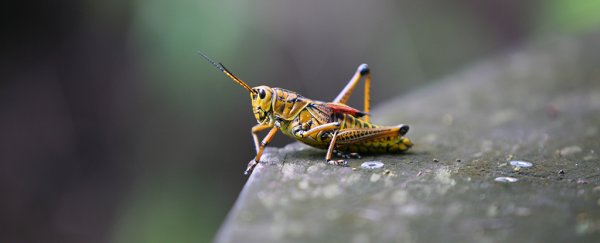From the fragrance of brewing coffee to the smell of rain soaking the soil, distinguishing scents is one of the reasons that having a sense of smell is wonderful.
But how smells such as coffee can be understood by our brain, no matter the season, location, or time is a complex question to answer. There's a huge number of neurons making up our olfactory bulb to help us make sense of the aromas around us.
So, researchers turned to an unlikely ally – locusts – to break down how smells such as coffee always smell like coffee, despite a myriad of other smells or other environmental factors potentially getting in the way.
"This feat of pattern recognition that is still difficult to achieve in artificial chemical sensing systems is performed by most sensory systems for their survival," the team from Washington University in St Louis wrote in their new paper.
"How is this capability achieved?"
The team first did a version of Pavlovian respondent conditioning on the insects, specifically an American grasshopper (Schistocerca americana). They placed an 'odorant' next to hungry locusts' antennas (which is how locusts smell) and then fed them a food reward. This caused the locusts' outer mouthparts – called maxillary palps – to open, which the researchers painted green for ease of viewing.
After a few rounds of this conditioning, the locusts would open their maxillary palps after just smelling the odorant, no food required. This response means that the locusts recognized the odorant, which is obviously an important first step.
While the locusts wore little sensors that monitored neural activity, the team then checked if the locusts could pick up the same smell in different conditions, such as dry or humid or changing intervals. While the locust palps opened each time, the neurons were activating in inconsistent patterns depending on the circumstances.
"The neural responses were highly variable," said one of the team, biomedical engineer Barani Raman.
"That seemed to be at odds with what the locusts were doing, behaviorally."
The researchers then brought in machine learning to determine what was going on. It became quickly apparent that there were a number of 'ON' neurons that turn on when an odorant is present and 'OFF' neurons that turn on when the odorant goes away. But they don't need to be perfect to work.
The locust's brain only needed the approximate amount of ON neurons being on and OFF neurons being off to tell the smell was there, with wiggle room to combat any changes for the differing conditions that would alter the smells.
While we can't relate these findings directly to humans, studying such responses within a simpler animal model like these insects can help us better understand some of the fundamentals of how olfactory systems work in general.
In this case, we now have a model of how a neural system can detect a specific smell amongst a cacophony of others and obscuring environmental factors.
You can see more about this in the video below.
Of course, we can't take too much of this study to relate to humans' much larger olfactory bulbs, but it is a fascinating piece of research. Hopefully, with more study, we can get to the bottom of just how our brains can understand the plethora of smells we're surrounded by in our everyday life, too.
The research has been published in PNAS.
